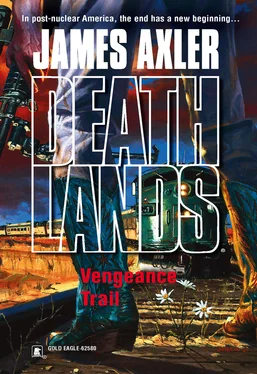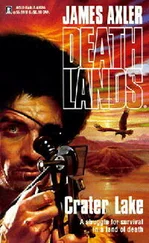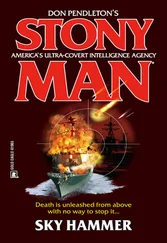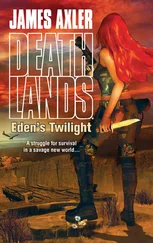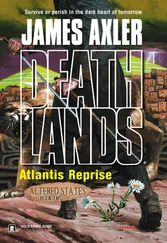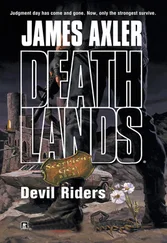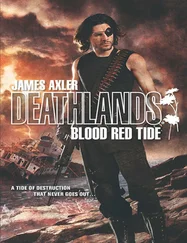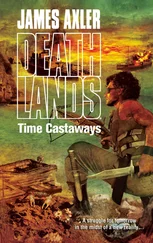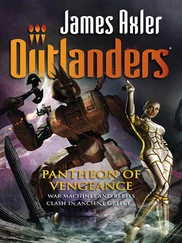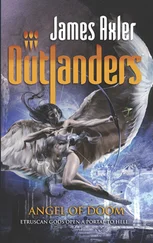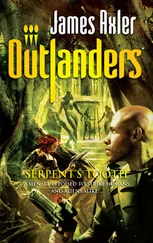Chato’s followers had bought it, anyway. Especially when it was presented with all the power of his magic gift for talking people into things. Which was what got him into this mess in the first place. But he had no choice now. It was go forward or die.
They’d catch him if he ran.
ONE OF IRONHEAD JOHNSON’S mountain men fired the opening round, the one that chilled Moredock, from a scoped and heavy barreled Remington 700. He lay on his belly on a low hogsback five hundred yards south of the train, and used his possibles bag for a rest. Johnson’s men were probably the most formidable fighters, man for man, of all the coldheart army. Johnson himself had disposed of the three-man observation post dug in on the rise, using his trademark foot-and-a-half-long, double-edged Arkansas toothpick.
At this point the track ran east and west straight as a laser beam. A road, its pavement still largely intact, but serving now mainly as a super-durable bed for layers of drifted sun-baked mud, ran along the south side of the embankment. The compound where the slave-laborers were sheltered under canvas was south of the road and the giant, gleaming, fusion-powered engine, to allow trucks to trundle back and forth carrying supplies from freight cars well back in the train.
From the east appeared a small fleet of dune buggies and wags, filled with young men waving longblasters. These were the Wild Boys, a local crew of coldhearts commanded by Wild Wess Wilhelm.
An arroyo cut from six to ten feet deep, with steep walls that had fallen in places because of rare but intensely savage downpours, ran at a diagonal south of the road, passing about two hundred yards from the slave stockade. From it now erupted most of the rest of Chato’s misfit army: El Gancho’s pistoleros from northern Mex, mounted on horseback.
Hogan’s contingent of fifteen outlaw bikers on lowslung, snarling sleds. No dirt bikes, to say the least, the heavy motorcycles had been wheeled by hand along the soft sand of the arroyo bottom, to a place where a cave-in provided a natural ramp. Small in numbers, his band was unsurpassed in cruelty.
Most of Red Wolf’s band of Plains Indian cutthroats had ridden off in a huff after their leader’s demise. However, staunch individualists that they were, seven or eight had remained and now joined the charge on their painted ponies.
And finally, twenty or so random chillers, who had drifted into the army at large, but not yet into any kind of affinity group. These loose ends had been sent off with the main body under the command of Bug Eye Mueller, who was suspected by many of being a mutie because of his unfortunately protuberant eyeballs, but who was so mean nobody ever so much as mentioned it.
The throat and purse-slitters of El Abogado, snoop and poop specialists all, formed no part of the attack. They had their own assignment.
And finally, Chato himself sat nervously on his paint pony atop a hill well to the south, leading from the rear where he could keep a good eye on the proceedings as was appropriate to a coldheart warlord of his stature. Or so he’d told his faithful followers.
No, it wasn’t a good plan. But it was shitloads better than admitting he’d drawn a blank, and having his coldheart followers decide to see what his insides looked like, preparatory to picking out a new leader.
“DOWN! Everybody get down!”
J.B. had already followed his own advice, and was speed-crawling toward the fallen corporal on leather-jacket clad elbows. Mildred, as seasoned a combat veteran as any, had also hit the dirt before the shot finished echoing.
Pretty much everybody else, guards and captives alike, was standing around, completely clueless to what was going down—even as two more guards were nailed by snipers.
However, not even the slowest or most stunned of wits could long mistake about 150 coldhearts, armed to the eyeballs and howling for blood, charging at them on horses, outlandishly modified motorcycles, and their own hind legs. The soldiers on guard, well-trained by Deathlands standards—meaning they had some—unslung their blasters, took up firing positions and started shooting.
So did the crews manning the heavy weapons mounted in casements and pop-up turrets on the armored wags of the train. MAGOG was like a weird monster millipede: its first ten or so segments were armor-plated, as were the very last two wags, a second engine and a gun-bristling caboose. Other armored wags were spaced at intervals among the more conventional freight and passenger wags. As he pulled Moredocks’s Beretta from its flap-covered field holster, the Armorer heard the snarl of 5.56 mm machine guns, the throaty growl of 7.62 mm M-60s and, sweetest of all, the Thor’s-hammer pounding of the .50-caliber Browning M-2. He could feel the muzzle-blasts, beating on the back of his jacket and stinging the exposed back of his neck.
Looking up, he saw the nearest attackers were still 150 yards off. He rifled the stiff for spare mags.
AS PLANS WENT, Chato’s wasn’t really all that bad. Given the resources, it was about as good as might have been come up with.
Of course, it was doomed. He’d been right about that.
For one thing, MAGOG carried more dedicated fighters than Chato had, not to mention another hundred or so support types, cooks and clerks, who could fire a CAR-15 or submachine gun out windows and firing ports about as well as anybody. And neither Chato nor any of his followers had the remotest conception of how much sheer firepower MAGOG mounted.
Two could play the sharpshooting game, for instance. There were four dedicated antisniper turrets, each containing a shooter behind a Barrett Light Fifty sniper rifle and a separate spotter, each using mounted optics far superior to what Ironhead Johnson and his boys had. As Johnson realized, peering at the train through ancient but excellent Zeiss binocs for the few short heartbeats before his head turned into pink mist. Not even iron was proof against a 709-grain jacketed slug traveling about four times the speed of sound, it turned out.
Nor had the coldhearts grasped the fact the General had dozens of machine guns of various calibers at his command. And here came the first serious hitch in the plan: however reluctant the rail wag soldiers may have been about firing up their own buddies, much less the laborers, many of their machine guns were mounted on top of the train, where they could fire right over the heads of guards and prisoners alike.
Then there were the automatic grenade launchers, and the 82 mm mortars that quickly began to chug and cause big gouts of earth and assorted body parts to spout up out of the desert.
And Wild Wess Wilhelm received the surprise of his life—and death, as it happened—when a rack popped out the top of the train’s engine. He didn’t see it, because it was infrared and invisible to the unaided eye, the laser-designation spot painted right on the pearly third snap-button of his shirt as he rode standing up behind the roll bar of his Baja buggy. He did see the puff of white smoke as the Hellfire antitank guided missile came off the rack, however.
He had time to shout a hysterical command to his driver, who was already yanking the wheel hard right in a turn, which would have rolled the buggy and spilled them all out to their deaths or at least painful and crippling injury. The huge missile, however, struck the lower edge of the roll bar before the tires had even broken loose in a skid. A jet of copper from the shaped-charge warhead, so incandescent hot it was almost plasma, simply vaporized young Wilhelm’s midsection and right shoulder and about half the head of the driver. Then the speeding wag began to roll broadside, but now as a ball of fire, trailing blazing fuel and a giant caterpillar of black smoke. Another buggy lost it, veered from the road and took off end for end trying to avoid the blazing wreck, scattering its occupants in every direction. And then the machine guns began raking the wags that were attacking along the road.
Читать дальше
